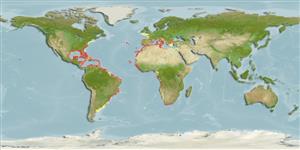Classification / Names
Common names from other countries
Main reference
Size / Weight / Age
Max length : 38.0 cm TL male/unsexed; (Ref. 7251); common length : 20.0 cm TL male/unsexed; (Ref. 2683); max. reported age: 8 years (Ref. 4742)
Environment
Marine; reef-associated; depth range 1 - 90 m (Ref. 3726)
Climate / Range
Subtropical, preferred ?
Distribution
Western Atlantic: North Carolina, USA and northern Gulf of Mexico (Ref. 7251) through the Caribbean to Brazil. Eastern Atlantic: France to Angola and including the Mediterranean, Azores, Madeira, Canary Islands, Cape Verde and Sao Tome Island.
Countries | FAO areas | Ecosystems | Occurrences | Introductions
Short description
Dorsal
spines
(total): 9;
Dorsal
soft rays
(total): 12;
Anal
spines: 3;
Anal
soft rays: 12. An elongate, very compressed fish with front of head forming a sharp edge. Snout very blunt; profile steep. Pale greenish, usually with no conspicuous markings on body (Ref. 26938). Head with alternating vertical lines of light blue and light yellow-orange (Ref. 13442).
IUCN Red List Status (Ref. 115185)
Threat to humans
Harmless
Human uses
Fisheries: minor commercial; gamefish: yes; aquarium: commercial
More information
ReferencesAquacultureAquaculture profileStrainsGeneticsAllele frequenciesHeritabilityDiseasesProcessingMass conversion
Tools
Special reports
Download XML
Internet sources
Estimates of some properties based on models
Phylogenetic diversity index
PD50 = 0.5005 many relatives (e.g. carps) 0.5 - 2.0 few relatives (e.g. lungfishes)
Trophic Level
3.5 ±0.1 se; Based on diet studies.
Resilience
Medium, minimum population doubling time 1.4 - 4.4 years (tmax=8)
Vulnerability
Moderate vulnerability (36 of 100)
Price category
